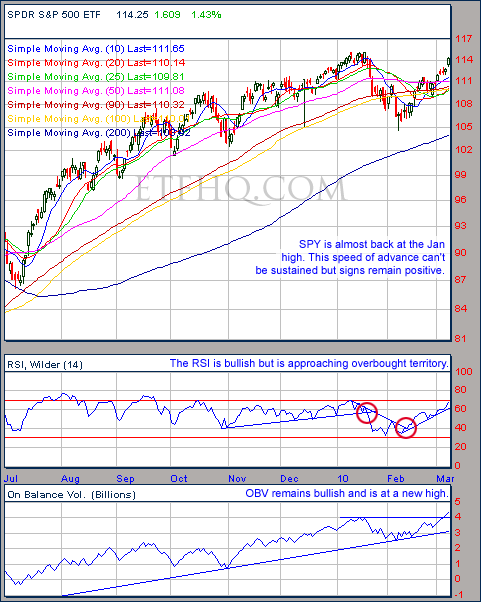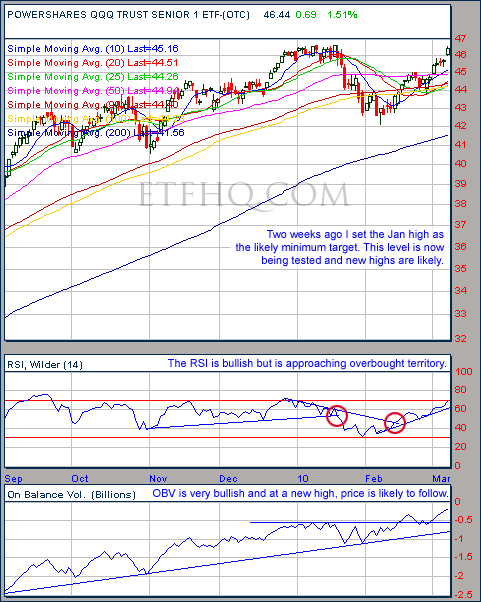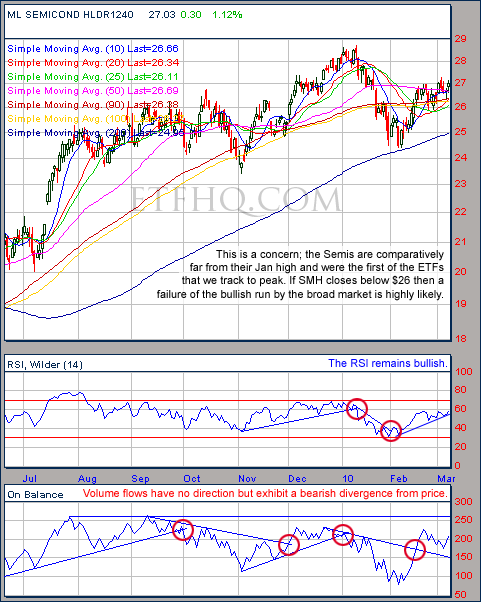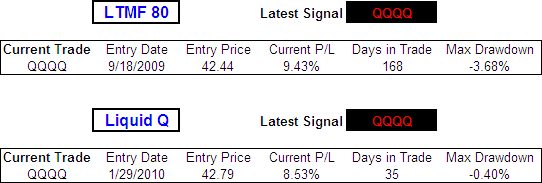.March 08, 2010 – 5:50 am ET
What a fun week to be on the right side of the market (although I closed my largest position which was short EWJ at small loss). Anyway, the breakout we were looking for occurred and as expected it was a violent one.
The target I set two weeks ago for QQQQ of the January high has been reached and IWM has convincingly surpassed this level powering on to a fresh high. This is all exceedingly positive but on the negative side the relative under performance of the semiconductors does raise concerns. Of the influential ETFs, SMH is the furthest from the January high bring the long term prospects of this rally into question.
.
ETF % Change Comparison
.

IWM had a stellar week advancing 6.08%. IYT was the worst performer but had a strong week prior.
The data in this table that currently warrens the most attention is the ‘% From peak’ and ‘Days Since Peak’. In the ideal world we should see SMH and IWM leading the market to new highs closely followed by QQQQ and IYT while SPY and DIA are dragged along for the ride. The fact that IWM has set the example of new highs while QQQQ and IYT and not far behind is very bullish and indicates that we are likely to see new highs from the broad market. However because SMH is lagging behind it is imperative that the semis at least maintain support otherwise the advance over the last month will have just been a fools rally.
.
What the % Comparison Table Tells Us:
By comparing the performance of the economically sensitive (SMH, QQQQ, IWM, IYT) and the comparatively stable ETFs (SPY and DIA) we can get an indication of the true market direction. The more sensitive areas of the market tend to be the first to initiate a trend change. For example if DIA and SPY sell off heavily while SMH and IWM (Russell 2000 small cap ETF) sell of mildly or continue moving to new highs then this would be very positive and vice versa.
The ‘Average Rank %’ is calculated by subtracting the % change for each ETF from the maximum % change and dividing it by the range for each period. 1-((MAX(% change all ETFs)-ETFs % Change)/(MAX(% change all ETFs)-MIN(% change all ETFs))) The readings for each period are then averaged. This reading is provided because if one ETF was significantly under/out performing the others then a plain high or low rank would not accurately reflect this.
.
![]()
.
A Look at the Charts
.

With OBV at a new high and little resistance overhead the prospects for SPY are very positive. However a new high from SPY is meaningless without QQQQ also doing the same. A pullback will have to come at some point and when it does all eyes should be on SMH for an indication of whether it is just profit taking or (another) trend reversal.
.

QQQQ has reached the target set two weeks ago and volume flows suggest that new highs are likely.
.

SMH must stay above $26 if the broad market is to break through and stay above the Jan high. A close below $26 would cause the broad market to pull back significantly. SMH would almost certainly test and probably break through its 200 day SMA which would put an end to the bullish trend.
Arguably the broad market is due for some profit taking now. The problem is that the Semis lack the cushion between price and support that the other ETFs currently possess. So if the profit taking occurs now it will put real pressure on SMH.
.

Last week I said that IWM was “one of the Jewels in the bullish argument” and it has not disappointed. Small caps stocks lack the ability of the Large Caps to weather economic storms. However when the economy is expanding the small caps can grow at a speed that the large caps simply can’t for the same reason that elephants don’t gallop. That is why it is so positive to see IWM leading the market through the Jan highs. If profit taking occurs this week then I will be watching that IWM stays above $64. A close back below the Jan high at this point would be a major failure by the bulls.
.

IYT is not far from making a new high and closer to doing so than the Dow Jones Industrial Average which will make the Dow theorists happy. It will be important that IYT confirms any new highs by SPY and DIA particularly seeing as SMH is not showing much strength.
.
![]()
.
OM3 Weekly Indicator
.

IWM has been on a strong buy signal for the last four weeks and has also been the top performer during that time advancing 12.40%. DIA has the weakest signal with a ‘Weak Buy’ which is actually positive because in a healthy market the Mega Caps should under-perform relative to the more economically sensitive segments.
.
How to read the OM3 indicator
The OM3 indicator as with most of our models primarily reads price action and volume. The strong/weak buy/sell signals are self-explanatory. ‘No Signal’ means that the component readings are in conflict and cancel each other out.
The alerts let you know if the cycle is speeding up or slowing down, so when you get at ‘Strong Buy, Bear Alert’ for instance it simply means that the criteria for a strong buy is in place but this weeks cycle reading is weaker (or more bearish) than last weeks reading (the same is true in reverse).
The number of weeks that a signal has been repeated is displayed. Historically a ‘Strong Buy’ signal has lasted for an average of 6 weeks and a maximum of 42 weeks, while a ‘Strong Sell’ has lasted for an average of 4 weeks and a maximum of 16.
This is an indicator not a mechanical trading model. It is useful to assist in analyzing the market but for the best results should be combined with commonsense and support/resistance levels etc.
.
![]()
.
TransDow & NasDow
.

The Transports remain dominant over the Dow and on Friday the NASDAQ also claimed dominance over the Dow. This is very positive as historically most bull markets have occurred when the NASDAQ and the transports were dominant.
.
What the TransDow Readings tell us:
The TransDow measures dominance between the DJ Transportation Index (DJTI) and the Dow Jones Industrial Average (DJIA). In a strong market the more economically sensitive Transportation Index should be dominant over the DJIA.
Historically the DJTI has been dominant over the Dow 45% of the time. The annualized rate of return from the DJTI during this period was 18.47% with the biggest loss for one trade sitting at -13.27%. The annualized return from the DJIA during the periods it was dominant over the DJTI was just 4.06% and the biggest loss for one trade was -16.13%. A 4% stop-loss is applied to all trades adjusting positions only at the end of the week.
What the NasDow Readings tell us:
The NasDow measures dominance between the NASDAQ and the DJIA. Using the same theory behind the Trans Dow; in a strong market the more economically sensitive NASDAQ should be dominant over the DJIA.
Historically the NASDAQ has been dominant over the DJIA 44% of the time. Taking only the trades when the NASDAQ is above its 40 week moving average the annualized rate of return was 25.47% with the biggest loss for one trade sitting at –8.59%. The annualized rate on the DJIA during the periods it was dominant over the NASDAQ is just 8.88% and the biggest loss for one trade was –12.28%. A 8% stop-loss is applied to all trades adjusting positions only at the end of the week.
.
![]()
.
LTMF 80 & Liquid Q
.

Both LTMF 80 and Liquid Q remain on buy signals and have clocked up some reasonable little profits so far. Internal reading on both remain strong.
.
Historical Stats:
.

.
How The LTMF 80 Works
LTMF stands for Long Term Market Forecaster. It reads volume flows relative to price action and looks for out performance of volume measured on a percentage basis over the prior 12 months. During a sustained rally the readings will reach high levels (near 100%) making it imposable for the volume reading to always outperform price so any reading above 80% will maintain the buy signal. This system has outperformed the market over the last 10 years but performance has been damaged by some nasty losses. It only produces buy signals and only for QQQQ.
How Liquid Q Works
Liquid Q completely ignores price action and instead measures the relative flow of money between a selection of economically sensitive and comparatively stable ares of the market. It looks for times when the smart money is confident and and can be seen by through volume investing heavily is more risky areas due to an expectation of expansion. This system has outperformed the market over the last 10 years and remained in cash through most of the major declines. It only produces buy signals and only for QQQQ. We will provide more performance details on the web site for these systems soon.
.
![]()
.
Summary
.
The market is displaying many positive signs including healthy volume flows, dominance by the NASDAQ and the Transports, several active buy signals and leadership from the small caps. Indications are that new highs from the broad market are very likely.
I don’t know about you but I find it very easy to produce evidence to support my current outlook no matter what it may be. If I am bullish then I see everything through rose tinted glasses. If I am bearish then I find the sinister side of everything.
For this reason it is important to always look for arguments against your outlook, cracks in your logic. Not to cause analysis paralysis but to identify specifically what would need to happen in order for you to close your positions or make adjustments. This way in the heat of the market you have a game plan, you have a contingency strategy in writing and don’t have to make it up as you go along.
The #1 bearish argument from a technical stand point at the moment is the relative under performance of the semiconductors. If SMH closes below $26 then I will be rethinking all bullish positions. If IWM closes below $64 then we are probably stuck in a crab market. A a new high by SPY will be meaningless without QQQQ doing the same and will still be lacking conviction without confirmation from IYT (Dow Transportation ETF).
Have a good week.
Any disputes, questions, queries, comments or theories are most welcome in the comments section below.
.
Derry
And the Team @ ETF HQ
.
![]()
.
The Devils Dictionary – C
Carry trade – The act of borrowing cheaply and lending at a higher rate. Popular with hedge funds when short-term rates collapsed after the dotcom bust. Charlie Munger of Berkshire Hathaway, “Never have so many people made so much money with so little talent.” See Greenspan.
Cash Flow – The movement your money makes as it disappears down the toilet.
CDO – Certain Death Obligation resulting from a number of causes ranging from mark to market accounting to too many NINJA loans in a pool of securities. A dumping ground for loans off-loaded by banks, which are pooled, sliced up and stamped with investment-grade ratings. Take a bunch of commercial loans for which there is collateral of some kind or other, smoosh them together into one big loan or bond and voilà! You have a CDO. Whether you want the CDO depends on how good the underlying loans and collateral are. It appears that many of the investment bankers selling CDOs were too busy buying houses in the Hamptons to find out.
Conspiracy – The only possible explanation for certain types of irrational price action. There’s a government conspiracy to support the stock market; how else could it have rallied 70% since March? A crackpot theory held by nut jobs who can’t admit when they’re wrong. Have those conspiracy theory wackos never heard of an oversold bounce before?